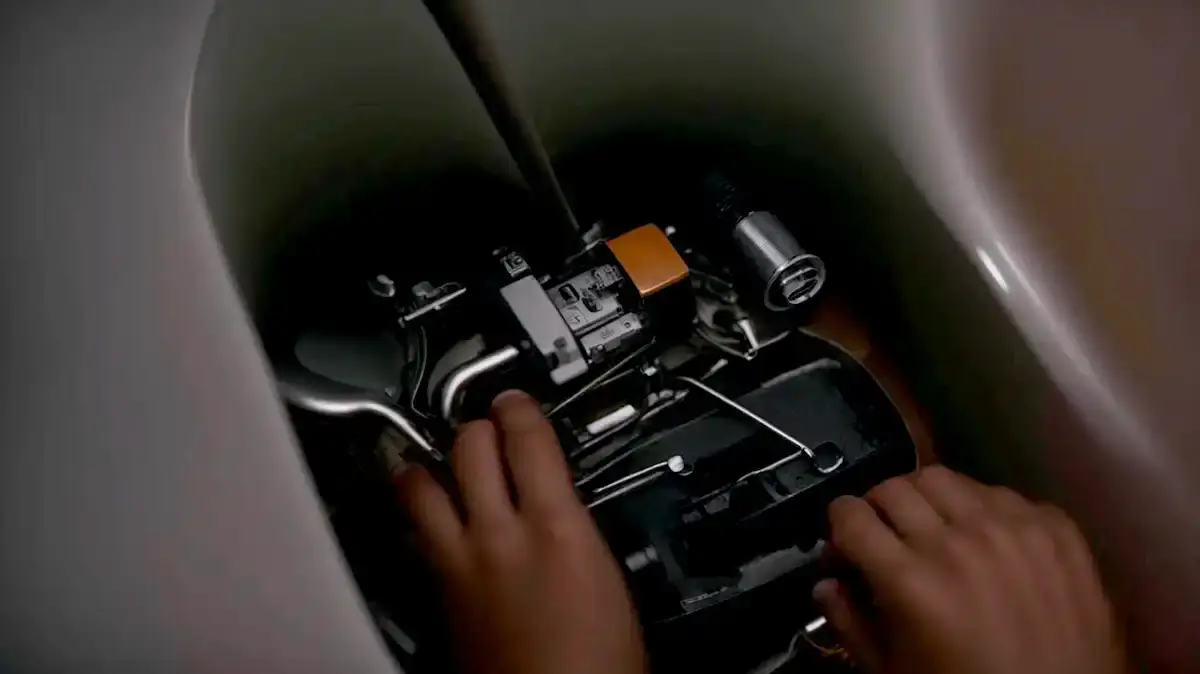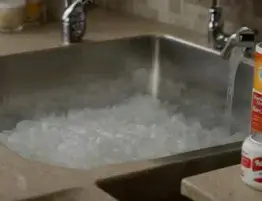
A toilet that runs randomly can disrupt the calm of any household; the unexpected noise, as much as the concern over water wastage, sends many homeowners scrambling for a solution.
Unraveling the mystery behind why a toilet continues to run necessitates a blend of curiosity, a willingness to undertake minor hands-on repairs, and an understanding of the underlying mechanics of your bathroom’s porcelain centerpiece.
This guide provides straightforward, DIY steps to diagnose and fix common issues that cause toilets to run intermittently.
Equipped with some basic tools and patience, anyone can transform into an amateur plumber.
Keep reading to master the simple repairs that will restore tranquility and ensure silence reigns once more in your bathroom sanctuary.
Unraveling the Mystery of a Running Toilet
An incessant running toilet can disrupt the tranquility of any household, signaling a need for attention buried within the mechanisms of your porcelain throne.
As homeowners confront the conundrum of ‘how do I stop my toilet from running randomly’, they must first recognize the tell-tale signs such as a phantom flush or an unexpected gurgle from the bathroom.
Understanding these symptoms leads to uncovering the underlying causes that trigger such arbitrary behavior in toilets.
Grasping the technicalities behind these watery woes forms the cornerstone of DIY toilet repair and sets the stage for effective, long-lasting solutions.
Recognizing the Signs of a Running Toilet
Spotting the early signals of a running toilet often escapes the notice of many, yet a discerning ear can detect anomalies in the bathroom’s auditory landscape. A continuously running toilet whispers the need for intervention, while a sporadic tank refill, when not in use, points to an internal leak – just two of the troublemakers in your bathroom symphony:
- Listen for unusual sounds emanating from the toilet, like hissing or trickling, that persist long after a flush.
- Watch for water flowing into the bowl without a flush, a visual cue that can often be spotted as a gentle ripple on the surface.
- Check the frequency of the toilet initiating a refill cycle; an increase may suggest a defect demanding attention.
Understanding Why Toilets Run at Random Times
Random occurrences of toilet running typically stem from flawed internal components that govern the flow and retention of water. A deteriorating flapper or a maladjusted float, both integral to the toilet’s filling mechanism, are common culprits. Professionals understand that rectifying these mishaps can reclaim the silence and efficiency of a well-functioning bathroom fixture.
Initial Inspections for the Untrained Eye
Navigating the labyrinth of DIY toilet repair can be manageable for those unfamiliar with plumbing intricacies.
Armed with a keen sense of hearing and a touch of curiosity, anyone can undertake the initial steps to diagnose a running toilet.
This essential preliminary examination sheds light on whether the haunting howl of your bathroom fixture indicates a straightforward fix or something that necessitates more advanced troubleshooting.
From zoning in on the subtle sounds of leakage to assessing the simplicity of the solution, these techniques pave the way for a serene bathroom environment, free from the random running of water.
How to Listen for a Running Toilet
Embarking on a journey to silence a running toilet begins with an auditory assessment; place your ear close to the bowl to discern any subtle trickles or groans that continue without pause. An attentive listener can often pinpoint the origins of these sounds, suggesting specific components at fault and guiding the subsequent repair process with precision.
Identifying if Your Issue Is a Simple Fix
Determining the complexity of a running toilet issue can often be a straightforward process: after lifting the tank lid, a visual check for any obvious signs of damage or wear on the rubber flapper or the float apparatus may indicate a basic problem that can be resolved with simple adjustments or part replacements.
| Issue | Signs to Look For | Possible Quick Fixes |
|---|---|---|
| Running Water | Constant hissing sound | Adjust the float |
| Phantom Flushes | Water trickles into bowl | Replace the flapper |
| Water Leaks | Water on the floor around toilet | Check the seal between tank and bowl |
Adjust the Flush Chain With Ease
Among the silent saboteurs in the realm of bathroom maintenance, an improperly adjusted flush chain is a noteworthy adversary.
Misalignment of the chain connecting the flush lever to the flapper may be the stealthy instigator behind your toilet’s random running.
When addressing this scenario, owners will uncover the simplicity behind mastering the flush chain’s placement and tension.
By locating and rectifying the chain length inside the tank, uninterrupted operation and water conservation are gloriously restored, transforming the restless howl into a harmonious hush.
Locate the Flush Chain Inside the Tank
Embarking on the journey to address the troublesome flush chain requires locating its precise position inside the toilet tank. The chain dangles from the toilet handle and descends to attach itself to the rubber flapper; its proper length and tension are pivotal for ensuring the flapper seals the water in the tank after each flush.
| Component | Locations to Inspect | Action for Resolution |
|---|---|---|
| Flush Chain | Connecting the handle to the flapper | Adjust the length and tension for optimal seal |
Correctly Attach and Adjust the Chain Length
Proper chain length is paramount; if too short, it will prevent the flapper from sealing completely, while an excessively long chain can become entangled, obstructing the flapper from lifting fully during a flush. Adjusting the chain to the optimal length necessitates a fine balance – it should have just a bit of slack when the flapper is closed to ensure the seal is tight and the toilet does not run randomly.
The Right Way to Replace a Worn Flapper
A relentless running toilet often traces back to a flapper compromised by wear or distortion. This issue contributes to not only water wastage but also the unsettling soundtrack of water trickling endlessly.
Mastery over replacing this critical component empowers individuals to silence the persistent flow and restore functionality to their restroom retreat.
In the forthcoming discussion, the focus will center on pinpointing a defective flapper and navigating through the tailored steps necessary to extract the old and usher in the new, ultimately reinstating the calm in your domestic sanctuary.
Identify a Faulty Flapper
To determine whether a flapper is at fault for random toilet running, one must inspect for signs of wear or deformation. A flapper that does not form a perfect seal can allow water to leak from the tank into the bowl, triggering the fill valve to replenish water unnecessarily: a classic scenario of the running toilet dilemma.
| Step | Inspection Criteria | Outcome |
|---|---|---|
| Visual Assessment | Check for cracks, warping, or decay | Signs of degradation call for replacement |
| Seal Test | Confirm flapper rests flush against the valve seat | Improper sealing indicates replacement is needed |
| Material Integrity | Assess the rubber for hardness or brittleness | Loss of flexibility suggests the flapper must be exchanged |
Steps to Remove and Install a New Flapper
Removing an old flapper and installing a new one starts with shutting off the water supply to the toilet to prevent a deluge during the operation. Next, flush the toilet to drain the tank, unhook the worn flapper from the flush valve’s ears, and detach the chain from the flush lever. Gently install the new flapper in reverse order: hook it onto the valve, reconnect the chain with minimal slack, and turn the water supply back on, ensuring the issue of the toilet running randomly is resolved with a fresh seal.
Tackling the Tank: Adjust the Float Valve
Among the less conspicuous yet pivotal players in the proper functioning of a toilet is the elusive float mechanism.
Nestled within the tank, this component determines the water level, maintaining a delicate balance between too much and too little.
Addressing issues with the float effectively ends the sound of a toilet that runs without pause.
This section elucidates on locating the float and fine-tuning its height to ensure the water level rests at an optimal point, thus quelling the unwanted symphony of continuously running water.
Find the Float Mechanism in Your Tank
The solution to a random running toilet often lies hidden within the tank, where the float mechanism resides. This component, vital for regulating water levels, floats on the surface, moving an arm that controls the fill valve. Discovering the float’s precise location, typically on the left side of the tank, is a fundamental step toward rectifying a toilet’s erratic behavior.
| Action | Description | Expected Outcome |
|---|---|---|
| Locate the Float | Find the floating device inside the toilet tank, usually attached to an arm. | Identification of the float mechanism provides a starting point for adjustments. |
Adjusting the Float for Proper Water Level
Mastering the nuances of float adjustment can be the key to halting the disruptive flow of a running toilet; by turning the adjustment screw or bending the float arm, one can lower or raise the water level to the manufacturer’s recommended height, usually marked inside the tank, which prevents overfilling and the resulting incessant running.
When to Call the Professionals for Help
Embarking on DIY repairs can be a cost-effective and satisfying venture, but there are instances when a running toilet speaks to a larger issue that eludes the grasp of keen homeowners.
Certain symptoms reveal that the problem may extend beneath the surface, where specialized tools and expertise are essential.
In such situations, understanding when to step back and embrace professional intervention becomes as crucial as the initial attempts to rectify the issue.
This is the moment to consider the warning signs that simple home fixes might not suffice and to explore the pathways to securing the assistance of skilled plumbers who can restore order to a disobedient bathroom fixture.
Signs That DIY Repairs Aren’t Enough
Despite the empowerment of executing DIY repairs, the persistent sound of a running toilet can sometimes defy simple solutions, indicating deeper plumbing problems. If repeated adjustments bring no reprieve or the issue returns with unnerving regularity, these are signs that professional plumbers should step in. Their specialized equipment and expansive knowledge ensure that elusive issues concealed within the labyrinth of home plumbing are effectively addressed, bringing the exasperating concert of a running toilet to a conclusive end.
By actively listening for unusual noises, performing a visual inspection, and adjusting the flush chain, float valve, or replacing a worn flapper, homeowners can effectively stop the wasteful and irritating ‘howl’ of a running toilet.
However, if the problem persists despite these efforts, it is important to recognize when to seek the expertise of professional plumbers to ensure a thorough and lasting solution.
If you’re a victim of a constantly running toilet and need help now, please contact us today!




